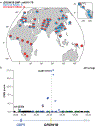Ancient selection for derived alleles at a GDF5 enhancer influencing human growth and osteoarthritis risk
- PMID: 28671685
- PMCID: PMC6556117
- DOI: 10.1038/ng.3911
Ancient selection for derived alleles at a GDF5 enhancer influencing human growth and osteoarthritis risk
Abstract
Variants in GDF5 are associated with human arthritis and decreased height, but the causal mutations are still unknown. We surveyed the Gdf5 locus for regulatory regions in transgenic mice and fine-mapped separate enhancers controlling expression in joints versus growing ends of long bones. A large downstream regulatory region contains a novel growth enhancer (GROW1), which is required for normal Gdf5 expression at ends of developing bones and for normal bone lengths in vivo. Human GROW1 contains a common base-pair change that decreases enhancer activity and colocalizes with peaks of positive selection in humans. The derived allele is rare in Africa but common in Eurasia and is found in Neandertals and Denisovans. Our results suggest that an ancient regulatory variant in GROW1 has been repeatedly selected in northern environments and that past selection on growth phenotypes explains the high frequency of a GDF5 haplotype that also increases arthritis susceptibility in many human populations.
Conflict of interest statement
COMPETING FINANCIAL INTERESTS STATEMENT
The authors declare no competing financial interests.
Figures







Similar articles
-
Heads, Shoulders, Elbows, Knees, and Toes: Modular Gdf5 Enhancers Control Different Joints in the Vertebrate Skeleton.PLoS Genet. 2016 Nov 30;12(11):e1006454. doi: 10.1371/journal.pgen.1006454. eCollection 2016 Nov. PLoS Genet. 2016. PMID: 27902701 Free PMC article.
-
Impact of broad regulatory regions on Gdf5 expression and function in knee development and susceptibility to osteoarthritis.Ann Rheum Dis. 2018 Mar;77(3):450. doi: 10.1136/annrheumdis-2017-212475. Epub 2018 Jan 8. Ann Rheum Dis. 2018. PMID: 29311146 Free PMC article.
-
Positive selection on the osteoarthritis-risk and decreased-height associated variants at the GDF5 gene in East Asians.PLoS One. 2012;7(8):e42553. doi: 10.1371/journal.pone.0042553. Epub 2012 Aug 14. PLoS One. 2012. PMID: 22905146 Free PMC article.
-
A comprehensive meta-analysis of association between genetic variants of GDF5 and osteoarthritis of the knee, hip and hand.Inflamm Res. 2015 Jun;64(6):405-14. doi: 10.1007/s00011-015-0818-9. Epub 2015 Apr 17. Inflamm Res. 2015. PMID: 25894512 Review.
-
[Genomic approaches to bone and joint diseases. Current status of genetic study of osteoarthritis].Clin Calcium. 2008 Feb;18(2):162-7. Clin Calcium. 2008. PMID: 18245884 Review. Japanese.
Cited by
-
Parallel Evolution at the Regulatory Base-Pair Level Contributes to Mammalian Interspecific Differences in Polygenic Traits.Mol Biol Evol. 2024 Aug 2;41(8):msae157. doi: 10.1093/molbev/msae157. Mol Biol Evol. 2024. PMID: 39073613 Free PMC article.
-
Expression of Human Interleukin 8 in Mice Alters Their Natural Behaviors.J Inflamm Res. 2022 Apr 13;15:2413-2424. doi: 10.2147/JIR.S355669. eCollection 2022. J Inflamm Res. 2022. PMID: 35444450 Free PMC article.
-
Functional Deficits in Mice Expressing Human Interleukin 8.Comp Med. 2020 Jun 1;70(3):205-215. doi: 10.30802/AALAS-CM-19-000049. Epub 2020 Apr 20. Comp Med. 2020. PMID: 32312361 Free PMC article.
-
Osteoarthritis year in review 2018: genetics and epigenetics.Osteoarthritis Cartilage. 2019 Mar;27(3):371-377. doi: 10.1016/j.joca.2018.10.004. Epub 2018 Oct 25. Osteoarthritis Cartilage. 2019. PMID: 30808485 Free PMC article. Review.
-
Genetics of hip dysplasia - a systematic literature review.BMC Musculoskelet Disord. 2024 Oct 1;25(1):762. doi: 10.1186/s12891-024-07795-2. BMC Musculoskelet Disord. 2024. PMID: 39354451 Free PMC article.
References
-
- Miyamoto Y et al. A functional polymorphism in the 5’UTR of GDF5 is associated with susceptibility to osteoarthritis. Nat Genet 39, 529–33 (2007). - PubMed
-
- Zhang R et al. A comprehensive meta-analysis of association between genetic variants of GDF5 and osteoarthritis of the knee, hip and hand. Inflamm Res 64, 405–14 (2015). - PubMed
METHODS-ONLY REFERENCES
-
- Iafrate AJ et al. Detection of large-scale variation in the human genome. Nat Genet 36, 949–51 (2004). - PubMed
-
- Settle SH et al. Multiple joint and skeletal patterning defects caused by single and double mutations in the mouse Gdf6 and Gdf5 genes. Dev Biol 254, 116–30 (2003). - PubMed
-
- Yang L, Mali P, Kim-Kiselak C & Church G CRISPR-Cas-mediated targeted genome editing in human cells. Methods Mol Biol 1114, 245–67 (2014). - PubMed
-
- McLeod MJ Differential staining of cartilage and bone in whole mouse fetuses by alcian blue and alizarin red. S. Teratology 22, 299–301 (1980). - PubMed
MeSH terms
Substances
Grants and funding
LinkOut - more resources
Full Text Sources
Other Literature Sources
Medical
Miscellaneous

